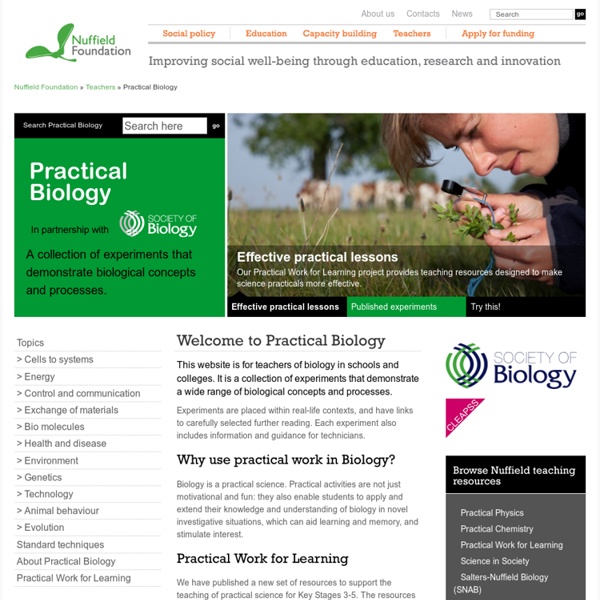Dive and Discover : Expeditions to the Seafloor
Practical Chemistry
This website is for teachers of chemistry in schools and colleges. It is a collection of experiments that demonstrate a wide range of chemical concepts and processes. Some of the experiments can be used as starting-points for investigations or for enhancement activities. Many have links to carefully selected further reading and all include information and guidance for technicians. Chemistry is a practical science. We have published a new set of resources to support the teaching of practical science for Key Stages 3-5.
ChemSpider | Search and share chemistry
Royal Society of Chemistry | Advancing the Chemical Sciences
Discover the world's most endangered species
Wildscreen's Arkive project was launched in 2003 and grew to become the world's biggest encyclopaedia of life on Earth. With the help of over 7,000 of the world’s best wildlife filmmakers and photographers, conservationists and scientists, Arkive.org featured multi-media fact-files for more than 16,000 endangered species. Freely accessible to everyone, over half a million people every month, from over 200 countries, used Arkive to learn and discover the wonders of the natural world. Since 2013 Wildscreen was unable to raise sufficient funds from trusts, foundations, corporates and individual donors to support the year-round costs of keeping Arkive online. As a small conservation charity, Wildscreen eventually reached the point where it could no longer financially sustain the ongoing costs of keeping Arkive free and online or invest in its much needed development. Therefore, a very hard decision was made to take the www.arkive.org website offline in February 2019.
Practical Physics
This website is for teachers of physics in schools and colleges. It is a collection of experiments that demonstrate a wide range of physical concepts and processes. Some of the experiments can be used as starting-points for investigations or for enhancement activities. Many have links to carefully selected further reading and all include information and guidance for technicians. Physics is a practical science. Practical activities are not just motivational and fun: they can also sharpen students’ powers of observation, stimulate questions, and help develop new understanding and vocabulary. Good quality, appropriate physics experiments and investigations are the key to enhanced learning, and clarification and consolidation of theory. We have published a new set of resources to support the teaching of practical science for Key Stages 3-5.
Virtual Sound Level Meter
The National Strategies - Schools
Since the National Strategies website closed in June 2011, a number of popular teaching resources have been updated and adapted to allow users to access them through the National Archives. A snapshot of NS Online the National Strategies website has also been archived by the National Archives Please be aware that the features previously available on the National Strategies site will not be available on the archived versions. For example, the personalised functions, external links, search boxes and navigation will not work. Also, the facility to log into or complete e-learning modules is no longer available. If you're looking for useful teaching resources, you may also like to visit our TES page. Another useful site for teaching resources is Teachfind .
Practical Biology
The Nuffield Curriculum Centre, in partnership with the Society of Biology, has developed a Practical Biology website for teachers of secondary school biology. The website allows teachers to download tried and tested biology experiments that should work in any school laboratory. The practicals can be used as starting-points for investigations and also for enhancement activities, such as clubs or open day events. The Project Although biology schemes of work and syllabi provide many opportunities for practical work, they cannot guarantee it. Reasons cited for the decline in the amount of practical work done in schools include health and safety concerns, cost, teacher confidence, lack of technical support, insufficient time and heightened emphasis on examination results. The Partnership The project is being progressed jointly by the Nuffield Curriculum Centre (NCC) and the Society of Biology, who together form the management board. Interested in getting involved?
Online Tone Generators - Highest Quality
Definition Also known as a test oscillator, function generator or waveform generator, a signal generator delivers an accurately calibrated output with adjustable frequency and amplitude. AudioCheck.net provides various signal generators optimized for use in audio and acoustics applications. Those specialized signal generators are often referred to as tone generators. Generating waveforms properly is not an easy task. Usage Unlike our other sections, the output of our tone generators will be downloaded straight to your computer as a .wav file. If you are looking to play audio tones straight from your web browser, please refer to our section labelled Sound Tests & Audio Test Tones.



